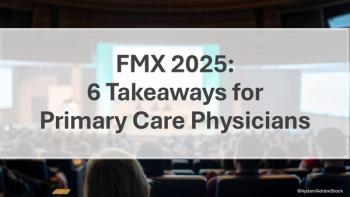
Adverse Drug Events and Older Patients: A Practical Approach
Adverse drug events were associated with an estimated 100,000 emergency hospitalizations involving older patients-US adults 65 years or older-during each of the years 2007, 2008, and 2009, according to a recent review of data from the National Electronic Injury Surveillance System-Cooperative Adverse Drug Event Surveillance project. Half of these occurred in persons 80 years or older, and women accounted for the majority of hospitalizations.1
For the very old (70 years or older), the study found, the hospitalization rate for adverse drug events is 3.5 times higher than for those aged 65 to 69 years.1 This finding has important public health implications because the fastest-growing segment of the US population is the group at greatest risk for adverse drug events.
There is a dramatic increase in the number of persons over the age of 65 and in particular, those 85 and older, who represent the fastest-growing segment of the US population. As adults age, they are more likely to use increasing numbers of both prescription and nonprescription medications, increasing the risk of drug interactions. Concomitant with this trend is the increased risk for inappropriate prescribing and adverse drug events. Such events have significant effects and contribute markedly to the morbidity and mortality of older patients.
It is important, then, that primary care providers are aware of some of the common scenarios in which adverse drug events may occur. Equally as important, providers need to help older patients understand the medications they are taking and the potential for negative drug interactions. When patients are aware of how their medications work, they may be less likely themselves to become the source of errors that lead to dangerous adverse drug events.
Adverse drug events are described as any injury resulting from the medical use of a drug. This may be the result of intrinsic properties of the drug, of drug interactions when one mediation is combined with others, or of inappropriate dosage. These situations tend to occur more commonly in older patients. By contrast, a medication error is defined as an error in medication use, which is usually the result of inappropriate prescribing and/or dispensing or an error in interpretation of other information related to use of the drug.
.
Four common medications or medication classes were implicated alone or in combination in 67.0% of emergency hospitalizations1: warfarin (33.3%), insulins (13.9%), oral antiplatelet agents (13.3%), and oral hypoglycemic agents (10.7%). High-risk medications were associated with only 1.2% of hospitalizations.1
Adverse drug events are also common among long-term–care and nursing home residents and contribute significantly to the morbidity, mortality, and health care costs in those populations. Living in a supervised and structured setting, therefore, does not guarantee protection for older adults from potential adverse drug events. Changes associated with aging, including loss of physiologic reserve, decline in hepatic and renal blood flow, and related metabolism, may render this population more vulnerable to adverse drug events. Long-term use of multiple drugs, or polypharmacy, is also common in older adults and poses a significant risk for untoward drug interactions.
By the year 2030, it is postulated that approximately 20% of the US population will be older than 65 years and that by the year 2030, approximately 40 to 60 million Americans will be members of this age group.2 With this demographic shift comes increased burden related to chronic illnesses such as diabetes, chronic obstructive pulmonary disease, emphysema, hypertension, glaucoma, and congestive heart failure. The combined effect of increased chronic disease burden and loss of physiologic reserve makes the aging population particularly susceptible to adverse drug events. Such events may be the result of prescribing errors, transcribing errors, and compounding errors, usually at the level of the pharmacy; and administration errors, usually at the level of nursing.
All physicians who treat older adults should be familiar with the risk factors mentioned here. These patients may take from 6 to 8 medications, sometimes prescribed by different professionals, as well as fortified over-the-counter medications. Primary care physicians, who see a large percentage of these patients, are in a particularly good position to take steps to help reduce adverse drug outcomes. I propose the following list of practical suggestions to help minimize adverse drug events in the aging population.
1. Review all medications at every patient encounter. This may mean having patients actually bring the prescriptions with them, commonly referred to in geriatrics as the “brown bag” approach. As a result of age-associated cognitive deficits and related changes, older patients may not be fully aware of the nature of the drug that has been prescribed for them. In addition, a typical older adult may see multiple practitioners, increasing the chance for use of multiple prescriptions and for inadvertent improper use. Support staff can easily review the contents of the brown bag and alert the physician to any concerns. The pharmacy may be a strong ally in identifying potential inappropriate dosages and dangerous interactions.
2. Make sure the patient has a concise list of medications and has a general understanding of why each drug has been prescribed. Many older adults have been given medications at one time and the provider may continue to prescribe the drug without any specific medical indication. Digoxin is an example of an agent that may have been prescribed for a condition that has resolved. But, as will be familiar to many physicians, there are cases in which it is easier to start a medication than to stop one in an older adult. Reviewing every medication at every visit and the actual medical need is another crucial step that primary care providers can take to reduce adverse effects. In many practices, support staff can provide or complete this review while the patient is waiting for the appointment.
3. Ensure at every visit that a patient is taking medications as prescribed. Cognitive impairment or more significant dementia may impair an older adult’s ability to take medication or to tolerate medication administration. In such cases, if there isn’t already a family member or other caregiver enlisted to help make sure prescribing directions are followed, the suggestion should be emphatically made. If you suspect cognitive deficit of some kind and that it may be contributing to improper use of medication, screening for memory loss may be appropriate. There are a number of brief cognitive screening tools available that are easily administered by primary care office staff. Sometimes older adults who are already being treated for cognitive deficits may not take those medications as prescribed. The result may be a perceived lack of efficacy and the clinician’s response may be to increase dosage, thereby increasing the risk for an adverse event.
4. Appreciate how the high cost of some medications may affect patient use of prescribed agents. Older adults, many of whom are on fixed incomes, may not be able to afford prescription medications, especially brand-name agents. Whenever possible, generic alternatives should be considered. It also is important that clinicians and support staff be aware of entitlements and other supplemental programs (eg, manufacturer couponing) that may be available to help defer the cost of certain medications. Although at first thought this responsibility may seem beyond the purview of the primary care provider, helping patients gain access to needed medications may help improve compliance and avoid possible adverse drug events.
5. Approach use of specific medications or drug classes with extreme caution. Certain medications for a variety of reasons may be inappropriate for routine use in older adults. Included in this group are long-acting benzodiazepines, certain NSAIDs, digoxin, and pherosulphate. In addition, routine use of tricyclic antidepressants, certain types of antihistamines, GI antispasmodics, and muscle relaxants may be potentially dangerous in older adults. I recommend that when any of these medications are prescribed, the prescriber reevaluate periodically the need for the drug and to discontinue it at the earliest possible time. The longer they are used, the more likely adverse outcomes will result. (See
Older adults experience many age-related conditions that are greatly improved through regular use of medications-and often multiple agents. A variety of factors may contribute to adverse drug events related to polypharmacy in this population. By following some of these practical suggestions, it is my hope that primary care clinicians can help reduce the opportunities for adverse events in our more vulnerable patients and prevent medication use from causing functional limitation.
References
1. Budnitz DS, Lovegrove MC, Shehab N, Richards CL. Emergency hospitalizations for adverse drug events in older Americans. N Engl J Med. 2011;365:2002-2012.
2. Trends in aging-United States and worldwide. MMWR Morb Mortal Wkly Rep. 2003;52:101-104, 106.
Suggested Readings
Tinetti ME. Preventing falls in elderly persons. N Engl J Med. 2003;348:42-49.
Varallo FR, Capucho HC, Planeta CS, et al. Safety assessment of potentially inappropriate medications (PIMs) use in older people and the factors associated with hospital admission. J Pharm Pharm Sci. 2011;14:283-290.
Levy HB, Marcus EL, Christen C. Beyond the Beers criteria: a comparative overview of explicit criteria. Ann Pharmacother. 2010; 44:1968-1975.
Fick DM, Cooper JW, Wade WE, et al. Updating the Beers criteria for potentially inappropriate medication use in older adults: results of a US consensus panel of experts. Arch Intern Med. 2003;163:2716-2724.
STARTing and STOPPing medications in the elderly. Pharmacist's Letter. Available at:
Barry PJ, Gallagher P, Ryan C, et al. START (Screening Tool to Alert doctors to the Right Treatment)-an evidence-based screening tool to detect prescribing omissions in elderly patients. Age Ageing. 2007;36:632-638.
Gallagher P, O’Mahony D. STOPP (Screening Tool of Older Person’s potentially inappropriate Prescriptions): application to acutely ill elderly patients and comparison with Beer’s criteria. Age Ageing. 2007;37:673-679.
Gallagher P, Ryan C, Byrne S, et al. STOPP (Screening Tool of Older Person’s Prescriptions) and START (Screening Tool to Alert doctors to Right Treatment). Consensus validation. Int J Clin Pharmacol Ther. 2008;46:72-83.
Ryan C, O’Mahony D, Byrne S. Application of STOPP and START criteria: interrater reliability among pharmacists. Ann Pharmacother. 2009;43:1239-1244.
Gallagher P, Baeyens J-P, Topinkova E, et al. Inter-rater reliability of STOPP (Screening Tool of Older Persons’ Prescriptions) and START (Screening Tool to Alert doctors to Right Treatment) criteria amongst physicians in six European countries. Age Ageing. 2009;38:603-606.
Gallagher PF, O’Conoor MN, O’Mahony D. Prevention of potentially inappropriate prescribing for elderly patients: a randomized controlled trial using STOPP/START criteria. Clin Pharmacol Ther. 2011;89:845-854.
Spinewine A, Swine C, Dhillon S, et al. Effect of a Collaborative Approach on the Quality of Prescribing for Geriatric Inpatients: a randomized, controlled trial. J Am Geriatr Soc. 2007;55:658-665.
Newsletter
Enhance your clinical practice with the Patient Care newsletter, offering the latest evidence-based guidelines, diagnostic insights, and treatment strategies for primary care physicians.






























































































































































































































































































